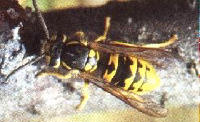 |
Wasp stingsThese are among the most serious stings, as they can cause severe, even fatal, allergic reactions. |
In Europe, wasps, bees and hornets are the most common culprits.
The venom is the same for all species, only the quantity varies. The action of the venom is always the same: a release of histamine. Stings inside the mouth are particularly serious.
The pain is immediate, and the dog will become agitated, whimper or even howl.
Once the dog has been calmed and restrained, an attempt must be made to neutralize the venom.
You can use a venom pump (sold in pharmacies).
You can also apply ice, wrapped in a cloth, to the site of the bite. This will both help destroy the venom and have an anti-edema effect.
Finally, disinfect carefully.
In the event of multiple stings, or a single sting in an allergic dog, or if the dog has swallowed the insect, even if it has been spat out, an anaphylactic reaction may occur - so take your dog to the vet immediately.
If you notice your dog feeling unwell in the next few minutes, or if you notice excessive agitation, prostration or hives, take him immediately to the nearest vet.
As a preventive measure, it is essential to
- Do not walk near beehives.
- Don't leave your dog in the sun with wet hair.
- Carry an emergency kit containing a disinfectant and an anti-histamine (available from your vet) when you take your dog for a walk in the forest or mountains, for example.
- Don't let your dog play at catching insects - he can't tell a fly from a wasp!







 English (United Kingdom)
English (United Kingdom)